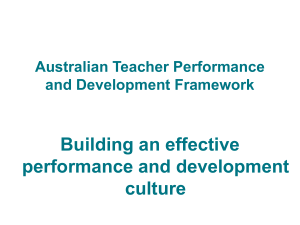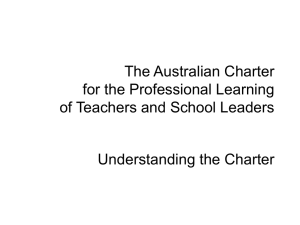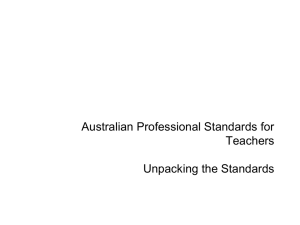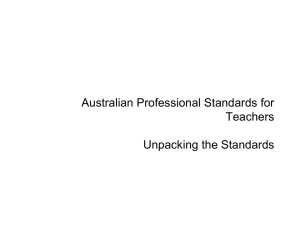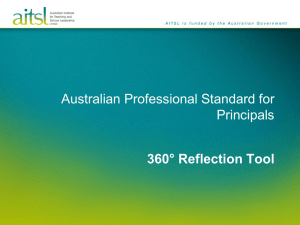Performance Management Position
advertisement
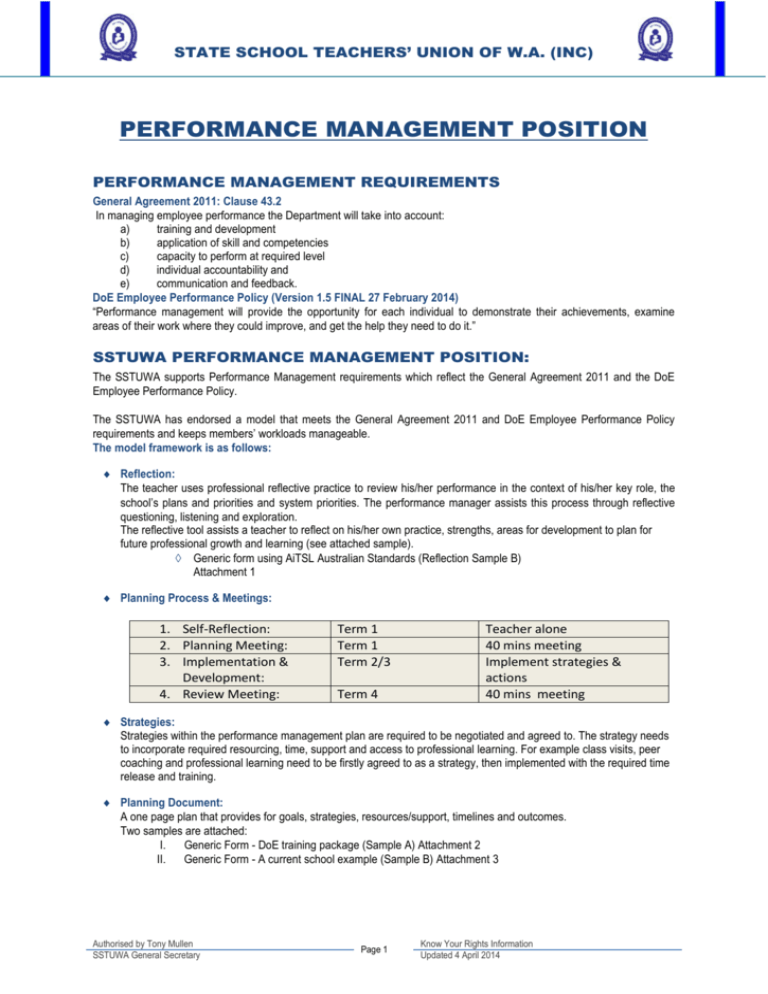
STATE SCHOOL TEACHERS’ UNION OF W.A. (INC) PERFORMANCE MANAGEMENT POSITION PERFORMANCE MANAGEMENT REQUIREMENTS General Agreement 2011: Clause 43.2 In managing employee performance the Department will take into account: a) training and development b) application of skill and competencies c) capacity to perform at required level d) individual accountability and e) communication and feedback. DoE Employee Performance Policy (Version 1.5 FINAL 27 February 2014) “Performance management will provide the opportunity for each individual to demonstrate their achievements, examine areas of their work where they could improve, and get the help they need to do it.” SSTUWA PERFORMANCE MANAGEMENT POSITION: The SSTUWA supports Performance Management requirements which reflect the General Agreement 2011 and the DoE Employee Performance Policy. The SSTUWA has endorsed a model that meets the General Agreement 2011 and DoE Employee Performance Policy requirements and keeps members’ workloads manageable. The model framework is as follows: ♦ Reflection: The teacher uses professional reflective practice to review his/her performance in the context of his/her key role, the school’s plans and priorities and system priorities. The performance manager assists this process through reflective questioning, listening and exploration. The reflective tool assists a teacher to reflect on his/her own practice, strengths, areas for development to plan for future professional growth and learning (see attached sample). ◊ Generic form using AiTSL Australian Standards (Reflection Sample B) Attachment 1 ♦ Planning Process & Meetings: 1. Self-Reflection: 2. Planning Meeting: 3. Implementation & Development: 4. Review Meeting: Term 1 Term 1 Term 2/3 Term 4 Teacher alone 40 mins meeting Implement strategies & actions 40 mins meeting ♦ Strategies: Strategies within the performance management plan are required to be negotiated and agreed to. The strategy needs to incorporate required resourcing, time, support and access to professional learning. For example class visits, peer coaching and professional learning need to be firstly agreed to as a strategy, then implemented with the required time release and training. ♦ Planning Document: A one page plan that provides for goals, strategies, resources/support, timelines and outcomes. Two samples are attached: I. Generic Form - DoE training package (Sample A) Attachment 2 II. Generic Form - A current school example (Sample B) Attachment 3 Authorised by Tony Mullen SSTUWA General Secretary Page 1 Know Your Rights Information Updated 4 April 2014 STATE SCHOOL TEACHERS’ UNION OF W.A. (INC) PERFORMANCE MANAGEMENT POSITION KEY INDUSTRIAL MATTERS FOR PERFORMANCE MANAGEMENT IMPLEMENTATION: 1. MEETING TIME FOR PERFORMANCE MANAGEMENT Time for performance management meetings is currently a matter in dispute. At the end of 2013 the DoE removed the provision of the 2.5 hours per FTE teacher for performance management meetings. This was one of the “budget cuts” measures imposed by the government. The union and the department are currently in dispute on Performance Management meeting time. This matter is being dealt with in the WAIRC. An outcome to this dispute is expected by the end of March 2014. Members will be advised of the Commission’s decision via eNews. 2. CLASSROOM OBSERVATION: In February 2014 the Education Department mandated classroom/peer observation for teachers. The SSTUWA raised this matter with the department as a matter of urgency and received the following response: "Peer observation is not mandatory. It is anticipated principals would implement peer observation in consultation with, and with the co-operation of, teachers in the context of their particular school culture, school priorities and available funds". Members please note: Peer observation is not mandatory. 3. CLASSROOM VISITS: The DoE Employee Performance Policy 2014 states the following under “Guidelines” page 5 1. PERFORMANCE MANAGEMENT PLAN The line manager and employee should develop a performance management plan (PMP) that contains goals, performance indicators, timeframes and agreed support that links to operational priorities. The DoE Employee Performance Policy 2014 states the following under “Guidelines” page 6 “As part of quality performance management feedback, a line manager can visit an employee in their classroom or work area. Observation of this nature provides an opportunity for ongoing constructive feedback and the determination of individual development needs. The above statements are “Guidelines” to the Employee Performance Policy. The SSTUWA advises school leader and teacher members that: ♦ ♦ Class visits and class observations as a strategy to improve a teacher’s performance needs to be agreed to between the parties, resourced with quality time and training and needs to be done by a qualified/trained colleague with the required area of expertise and trust. Where members have class observations imposed as a performance management strategy without the above negotiations and agreement the member is advised to move to dispute and seek alternative strategies or an alternative school leaders or colleague to manage the class observation/visits strategy. Authorised by Tony Mullen SSTUWA General Secretary Page 2 Know Your Rights Information Updated 4 April 2014 STATE SCHOOL TEACHERS’ UNION OF W.A. (INC) PERFORMANCE MANAGEMENT POSITION 4. AITSL AUSTRALIAN PROFESSIONAL STANDARDS FOR TEACHER ♦ ♦ ♦ ♦ ♦ ♦ The department mandated the use of the AITSL Australian Professional Standards for Teacher as the performance management framework to support the process. This means the standards are to be used as the reflection tool, which guides the plan for teacher development and improvement. It does not mean that strategies and resources promoted on the AITSL website are mandated e.g. 360 degree feedback and peer observation. This means the framework is used to guide the reflection, to guide the planning document, to guide the negotiated strategies to meet the agreed goals. The union alerts members to the use of AITSL Australian Professional Standards for Teacher as an appraisal tool or a simplistic assessment checklist tool – e.g. classroom inspections. The Employee Performance Policy continues to require a negotiated plan that focuses on the identified needs of the teacher – the AITSL Australian Professional Standards for Teacher are now the framework that the teacher and line manager use to identify the areas where support and improvement needs to occur. THE SSTUWA DOES NOT SUPPORT PERFORMANCE MANAGEMENT MODELS WHERE: ♦ ♦ ♦ ♦ ♦ ♦ ♦ ♦ ♦ ♦ Reflection tools are used as assessment or appraisal tools (where someone else is assessing or judging your performance). “Coaching models” are imposed on members. Peer observation/classroom observation is mandated and implemented without negotiation, training, quality time and resources. Classroom visits are imposed on members (the policy requires these to be negotiated strategies, that means, the strategy is agreed to by both parties). AITSL Australian Professional Standards for Teacher is used as an appraisal tool or a simplistic assessment checklist tool – e.g. classroom inspections. Requirements to hand over student samples and student assessments are imposed (sharing samples of student work is appropriate IF it is connected to a self-reflection, planning and review process). Requirements to present planning/program documents are imposed on all staff with no differentiation or without planning being identified as an area that needs improvement (sharing samples of planning relevant to your reflection results is adequate and would ensure a safe collegiate learning environment). More than two goals or areas of development as a full-time teacher (and one as a part-time teacher) are expected as part of the process; Appraisal and accountability processes are imposed into Performance Management (they belong in whole school review meetings and whole school accountability processes); and Whole school Business Plan and School Development Plan Reviews are being placed into individual performance management plans rather than being managed collaboratively as part of a whole school review process. Authorised by Tony Mullen SSTUWA General Secretary Page 3 Know Your Rights Information Updated 4 April 2014 STATE SCHOOL TEACHERS’ UNION OF W.A. (INC) PERFORMANCE MANAGEMENT POSITION PERFORMANCE MANAGEMENT V PERFORMANCE APPRAISAL The DOE Policy and DoE training packages have endorsed a developmental model for performance management, not an appraisal model. Here is a summary of the difference between Performance Management and Performance Appraisal: Performance Management Focus is on future performance Emphasis is on continuous progress Performance Appraisal Focus is on past performance Emphasis is on assessment at a set end point Participants focus on a small number of agreed aspects of the employees job The PM Plan (goals, strategies, resources, review) is negotiated and agreed to by the two parties The approach is collaborative Reflective tool assists a teacher reflect on their own practice, strengths, areas for development to plan for future professional growth and learning Strategies are negotiated between the parties: e.g. Coaching: is a professional learning process of collaborative planning, observation and feedback. It is teacher owned, it is resourced, and the coach is trained. It is one of a number of strategies directly related to the identified needs of the teacher. Classroom visits are negotiated and agreed. The focus is on support, mentoring and professional learning. Participants focus on ownership of every aspect of the employee’s job. The PM Plan (goals, strategies, resources, review) is set by the employer. The approach is inspectorial Reflective tools are used as assessment tools: to measure and record past & current practice as the benchmark for a final assessment at the end of the process. Strategies are imposed by the line manager: e.g. Coaching: is imposed by management – often as a whole school approach. The coach is selected by management and imposed on the teacher. The coach follows an assessor/inspectorial model. The coaching is not targeted at previously agreed areas or goals. Classroom visits are imposed. They focus on inspectorial and observations for the purpose of assessing or appraising the teacher. GRADUATE TEACHER REGISTRATION REQUIREMENTS: Please note: The Teacher Registration Board of WA grants new teachers provisional registration for up to three years. To move from provisional to full registration, graduate teachers have to meet the requirements of the National Professional Standards for Teachers at the Proficient stage. There are two ways that this can occur: ♦ The Mentor Transition Process; or ♦ Graduate Teacher Induction Program (GTIP) Transition Process. These processes require principals to sign off. The Graduate Teacher registration process is separate from Performance Management and should not be used as a substitute for, or alternative to, Performance Management. SSTUWA MODEL DOCUMENTS: The following model documents are attached: 1. Reflective Tool: AISTL Australian Professional Standards for Teachers 2. Performance Management Plan Sample A 3. Performance Management Plan Sample B Authorised by Tony Mullen SSTUWA General Secretary Page 4 (Attachment 1) (Attachment 2) (Attachment 3) Know Your Rights Information Updated 4 April 2014 STATE SCHOOL TEACHERS’ UNION OF W.A. (INC) PERFORMANCE MANAGEMENT POSITION BRANCH AND UNION REPRESENTATIVE ACTION: I. II. III. IV. V. Table and discuss the SSTUWA Performance Management position and samples. (Reflective tools and Performance Management Plans). Compare these to your current school model. Determine which parts of the SSTUWA framework best meet the needs of members at your workplace and which members decide to adopt. Union Rep/s advises and meets with the principal to provide member feedback and seek agreed implementation of the members’ options. Inform all members of the outcome of this meeting. Commence implementation of the agreed Performance Management model or if agreement is not reached, seek support and advice from your school’s district organiser to progress negotiations and resolution of the matter. Authorised by Tony Mullen SSTUWA General Secretary Page 5 Know Your Rights Information Updated 4 April 2014 STATE SCHOOL TEACHERS’ UNION OF W.A. (INC) PERFORMANCE MANAGEMENT POSITION ATTACHMENT 1 PERFORMANCE MANAGEMENT: REFLECTION TOOL: CLASSROOM TEACHER AITSL Australian Professional Standards for Teachers 1) Reflect on each standard and consider your current teaching role and practice. 2) Highlight those areas that you need further development and support with. 3) Identify specific aspects of this standard in the context of your current role – right side box. 4) Share these for the planning meeting to identify your 2/3 goals. AITSL Australian Professional Standards for Teachers STANDARD 1: KNOW STUDENTS AND HOW THEY LEARN 1.1 1.2 1.3 1.4 1.5 1.6 Physical, social and intellectual development and characteristics of students Understand how students learn Students with diverse linguistic, cultural, religious and socioeconomic backgrounds Strategies for teaching Aboriginal and Torres Strait Islander students Differentiate teaching to meet the specific learning needs of students across the full range of abilities Strategies to support full participation of students with disability STANDARD 2: KNOW THE CONTENT AND HOW TO TEACH IT 2.1 Content and teaching strategies of the teaching area 2.2 Content selection and organisation 2.3 Curriculum, assessment and reporting 2.4 Understand and respect Aboriginal and Torres Strait Islander people to promote reconciliation between Indigenous and non-Indigenous Australians 2.5 Literacy and numeracy strategies 2.6 Information and Communication Technology (ICT) STANDARD 3: PLAN FOR AND IMPLEMENT EFFECTIVE TEACHING AND LEARNING 3.1 3.2 3.3 3.4 3.5 3.6 3.7 Establish challenging learning goals Plan, structure and sequence learning programs Use teaching strategies Select and use resources Use effective classroom communication Evaluate and improve teaching programs Engage parents/carers in the educative process Authorised by Tony Mullen SSTUWA General Secretary Page 6 Know Your Rights Information Updated 4 April 2014 STATE SCHOOL TEACHERS’ UNION OF W.A. (INC) PERFORMANCE MANAGEMENT POSITION STANDARD 4: CREATE AND MAINTAIN SUPPORTIVE AND SAFE LEARNING COMMUNITIES 4.1 4.2 4.3 4.4 4.5 Support student participation Manage classroom activities Manage challenging behaviour Maintain student safety Use ICT safely, responsibly and ethically STANDARD 5 ASSESS, PROVIDE FEEDBACK AND REPORT ON STUDENT LEARNING 5.1 5.2 5.3 5.4 5.5 Assess student learning Provide feedback to students on Make consistent and comparable Interpret student data Report on student achievement their learning judgements STANDARD 6: ENGAGE IN PROFESSIONAL LEARNING 6.1 6.2 6.3 6.4 Identify and plan professional learning needs Engage in professional learning and improve practice Engage with colleagues and improve practice Apply professional learning and improve student learning STANDARD 7: ENGAGE PROFESSIONALLY WITH COLLEAGUES, PARENTS/CARERS AND THE COMMUNITY 7.1 7.2 7.3 7.4 Meet professional ethics and responsibilities Comply with legislative, administrative and organisational Engage with the parents/carers Engage with professional teaching networks and broader requirements communities REFERENCE: AITSL Australian Professional Standards for Teachers For detailed examination of the standards identified for your growth and development use the above reference if required. http://www.teacherstandards.aitsl.edu.au/ Authorised by Tony Mullen SSTUWA General Secretary Page 7 Know Your Rights Information Updated 4 April 2014 STATE SCHOOL TEACHERS’ UNION OF W.A. (INC) PERFORMANCE MANAGEMENT POSITION ATTACHMENT 2 PERFORMANCE MANAGEMENT PLAN STAFF MEMBER MANAGER AGREED RESPONSIBILITIES: FOCUS FOR IMPROVEMENT (Goal/Target) STRATEGIES – SMART TARGETS PD RESOURCES & SUPPORT OUTCOMES ACHIEVED FEEDBACK: SIGNED ________________________________________________________ DATE __________________________ TEACHER/ MANAGER Authorised by Tony Mullen SSTUWA General Secretary Page 8 Know Your Rights Information Updated 4 April 2014 STATE SCHOOL TEACHERS’ UNION OF W.A. (INC) PERFORMANCE MANAGEMENT POSITION ATTACHMENT 3. PERFORMANCE MANAGEMENT PLAN Negotiated Performance Goal/s: 1. 2. Strategies to be undertaken Resources and support required Agreed Timeline Success indicators – How will I know my goal is achieved? Review: Staff Member Performance Manager Date If you have any problems please discuss with your Union Representative and/or branch. Should further assistance be required please don’t hesitate to contact Member Assist on 9210 6060 or 1800 106 683. Email enquiries@sstuwa.org.au Authorised by Tony Mullen SSTUWA General Secretary Page 9 Know Your Rights Information Updated 4 April 2014
